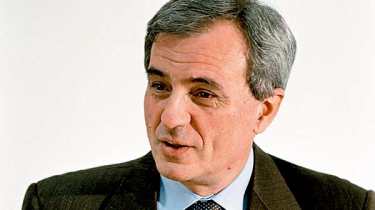Tyres: the inside line
Pirelli’s R&D man on Ferrari, the future of tyres, and F1
We arrived at Pirelli’s world headquarters in downtown Milan some time ago, but there’s still a long way to go before we’re face to face with Maurizio Boiocchi, Pirelli’s senior vice president of product and R&D, whose office is apparently at the heart of the slick, glass temple we’re now entering.The level of security around here is extraordinary. First there’s a complex pass needed simply to gain access to the compound. Next, another set of forms needs completing before you can gain admission to the headquarters building itself. There then follows endless swiping of security cards to enable several doors to be opened along the blindingly white corridors before, finally, we reach the door to Boiocchi’s office. The man himself ushers me over to a table by a window which reaches from the floor to ceiling, overlooking this industrial corner of Milan. We begin by talking about the recent Ferrari 599 launch.I’m interested to know how Pirelli goes about developing the bespoke tyres for such a car. Boiocchi admits that this is the glamorous end of the business, which in the case of the 599 project kicked off in October 2004, when several manufacturers were given the opportunity to look at developing tyres for the new Ferrari, to be ready for shakedown tests at Fiorano beginning in March 2005. Boiocchi explains that at this early stage the main focus is on the balance of the car at the limit of adhesion. Ideally the grip should be lost progressively rather than suddenly, with plenty of feel coming through to the driver as the limit is approached. It’s this gradual ‘speed off’ (as he likes to term it) that Boiocchi describes as the very DNA of Pirelli performance tyres.The compound mix is the key factor here – the stiffer the compound, the better the turn-in, but more stiffness leads to lower ultimate grip, so it becomes a trade-off between the two. It’s the same with braking/acceleration stability, which improves with greater carcass flexibility, but too much flexing and cornering starts to suffer. Another tweak tyre manufacturers use to improve stability at the limit is to reduce tread depth, which in the case of the Ferrari 599 means just 5.25mm for the rears, while the fronts have a greater depth of 7.4mm to help reduce aquaplaning.Interestingly, Boiocchi says that the performance gap between different makes of high-performance tyre is much wider than it is with more conventional tyres. Pirelli sees lap times at its Vizzola test track vary by around 1.5sec with different makes of general-use tyres but by up to 3.5sec with performance tyres.After the initial shakedown with Ferrari, Pirelli made some further tweaks before resubmitting a final set of tyres in May 2005 for another session of lapping at Fiorano. This was followed by wet-grip trials at Vizzola with a development car, and, finally, an on-road durability assessment, which took place around the same time. In October 2005, Ferrari gave its chosen tyre manufacturers (including Pirelli) the final go-ahead to put the 599 tyres into production. They’re handmade in batches of 100 at Pirelli’s competition department in Turin – Boiocchi points out that wherever in the world a 599 customer buys a replacement set of tyres, all will have originated at the competition factory in Turin. Boiocchi also heads up the competition department. So I ask if Pirelli would ever consider becoming an F1 tyre supplier again. Boiocchi doesn’t hesitate in saying no, citing the main reasons as the sheer cost of involvement in F1 and the minimal opportunities for technology transfer between F1 and road tyres, the dimensions currently used in F1 being unique in motorsport and a world away from road tyres.Pirelli has found far more success in supplying competition tyres to rally and superbike teams, as there’s a direct relationship between this kind of motorsport and high-performance road tyres. This is particularly applicable with bike tyres, where a good result on the track can lead to a sudden increase in road-tyre sales.Looking to the future, Boiocchi thinks the recent increases in tyre sizes are coming to an end. If anything, tyres could get smaller as fuel efficiency becomes more of an issue. Big tyres need bigger wheels, which leads to stronger (and therefore heavier) suspension components needed to control the greater mass. Run-flat tyres complicate matters further. There’s no fixed definition of what exactly a run-flat is and how long it should last when punctured. Suspension components also need beefing-up to handle the extra weight in the tyre… I can sense Boiocchi isn’t keen on them. He points out that punctures are becoming a thing of the past anyway, thanks to the latest carcass construction methods.It’s time to go. As I leave, Boiocchi is handed a sheet of the times from a European GT championship test session. His face lights up – Pirelli is filling the first few places.Tyre manufacturing is a seriously competitive business, and Pirelli is determined to use motorsport to keep them at the front. From evo’s experience of the Ferrari 599, it seems to be working nicely.



